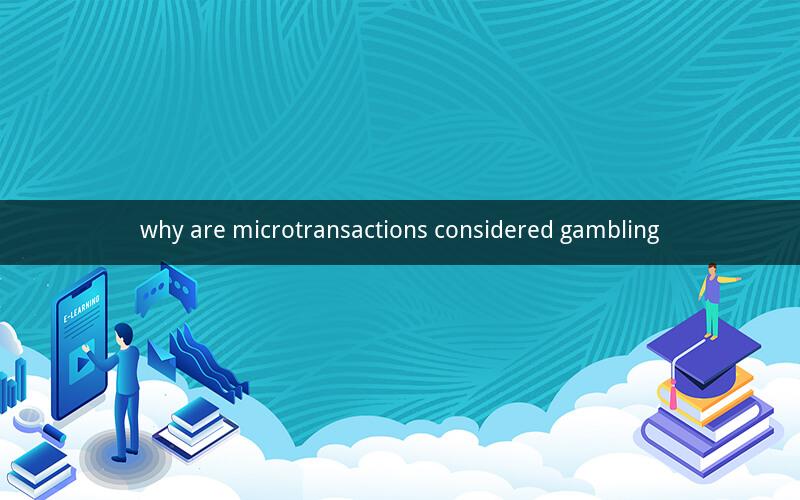
Table of Contents
1. Introduction to Microtransactions
2. The Definition of Gambling
3. The Blurring of Lines: Microtransactions and Gambling
4. Psychological Factors at Play
5. Financial Implications
6. The Role of Design and Game Mechanics
7. Industry Regulations and Consumer Protection
8. The Impact on Society
9. Conclusion
1. Introduction to Microtransactions
Microtransactions have become a staple in the gaming industry, offering players the opportunity to purchase in-game items, cosmetics, and other enhancements. These transactions are typically small, ranging from a few cents to a few dollars, and are often facilitated through in-game currency or real-world currency.
2. The Definition of Gambling
Gambling, on the other hand, is generally defined as risking something of value on an event with an uncertain outcome, with the primary intent of winning additional value. This definition encompasses a wide range of activities, from traditional casino games to sports betting.
3. The Blurring of Lines: Microtransactions and Gambling
The distinction between microtransactions and gambling can sometimes be blurred. When players engage in microtransactions, they are often doing so with the hope of improving their in-game experience, whether that's through cosmetic changes or additional in-game assets. However, the nature of these transactions can sometimes resemble gambling, as players are investing real money in the hope of receiving a favorable outcome.
4. Psychological Factors at Play
Several psychological factors contribute to the gambling-like nature of microtransactions. The "binge buying" phenomenon, where players spend increasingly more money in pursuit of a desired outcome, is one such factor. Additionally, the use of psychological triggers, such as limited-time offers and the illusion of scarcity, can encourage players to make impulse purchases.
5. Financial Implications
The financial implications of microtransactions can be significant. For some players, the cost of these transactions can add up over time, leading to financial strain. In extreme cases, players may go into debt to fund their gaming habits, a scenario that has been compared to gambling addiction.
6. The Role of Design and Game Mechanics
The design and game mechanics of many modern games play a crucial role in fostering a gambling-like experience. Features such as loot boxes, which offer randomized rewards, can create a sense of uncertainty and excitement similar to that found in traditional gambling activities.
7. Industry Regulations and Consumer Protection
The gaming industry is increasingly being called upon to implement stricter regulations and consumer protection measures. Many governments have introduced laws aimed at preventing minors from engaging in microtransactions and have implemented age verification systems to ensure compliance.
8. The Impact on Society
The rise of microtransactions and the potential for gambling-like experiences within games has raised concerns about the impact on society. Issues such as addiction, financial hardship, and the normalization of gambling behaviors among younger generations are areas of concern.
9. Conclusion
While microtransactions and gambling share some similarities, the distinction between the two remains important. The gaming industry must continue to evolve and adapt its practices to ensure that players are not inadvertently exposed to gambling-like experiences, particularly when it comes to younger audiences.
---
Questions and Answers
1. Q: What is the primary difference between microtransactions and gambling?
A: The primary difference is the intent behind the transaction. Microtransactions are typically designed to enhance the in-game experience, while gambling involves risking something of value with the hope of winning additional value.
2. Q: Can microtransactions lead to gambling addiction?
A: Yes, microtransactions can lead to gambling addiction, particularly if they involve elements of chance and the potential for financial gain.
3. Q: How can the gaming industry better protect consumers from the negative effects of microtransactions?
A: The gaming industry can implement stricter age verification systems, provide clear information about the risks of microtransactions, and offer tools for players to manage their spending.
4. Q: Are loot boxes considered a form of gambling?
A: Whether loot boxes are considered gambling depends on the specific regulations of a given jurisdiction. However, many argue that the element of chance and the potential for financial gain makes them similar to gambling.
5. Q: How can parents monitor their children's spending on microtransactions?
A: Parents can monitor their children's spending by using parental control features provided by game platforms, setting spending limits, and having open conversations about the importance of managing finances.
6. Q: Is there a risk of children being exposed to gambling-like experiences through microtransactions?
A: Yes, there is a risk, especially if children are not aware of the potential for financial loss and the gambling-like aspects of microtransactions.
7. Q: How do developers design games to encourage microtransactions?
A: Developers often use psychological triggers, such as limited-time offers, the illusion of scarcity, and social proof, to encourage players to make microtransactions.
8. Q: What are the consequences of microtransactions on the gaming industry's reputation?
A: Microtransactions can damage the gaming industry's reputation if they are perceived as manipulative or if they lead to negative outcomes for players, such as addiction or financial hardship.
9. Q: How can governments regulate microtransactions to protect consumers?
A: Governments can regulate microtransactions by implementing laws that require age verification, limit spending amounts, and provide clear disclosures about the risks involved.
10. Q: What steps can players take to avoid becoming addicted to microtransactions?
A: Players can take steps such as setting spending limits, being aware of the psychological triggers used by developers, and seeking help if they feel they are losing control over their spending.